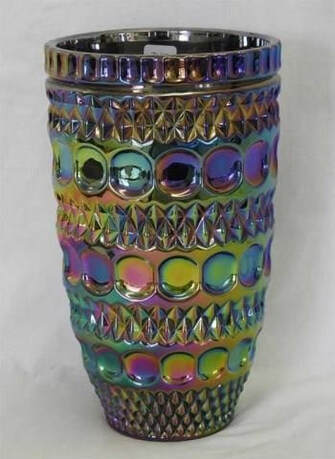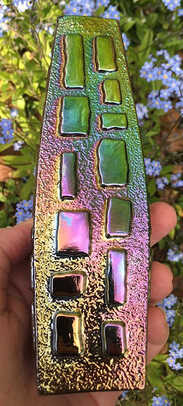Leinauer Glaswaren “LGW”.
S&G Thistlewood: 1999-2000, updated and extended through to 2021.
|
In the late 1990s, several items of unattributed, pressed glass were reported, with a vivid and often breath-taking iridescence.
Our research led us to the European pressed glass expert, Siegmar Geiselberger, and in 2000, we published the following feature article in our Carnival NetworK journal, explaining to the glass world exactly what these fascinating items were.
Our full article is re-published below – the two photos are not the original black & white ones, but are instead recent versions of the originals. |
Eye of the Peacock bowl (with LGW label). It is 9¾ inches x 10 inches.
Both pictures courtesy Alan Henderson. |
|
Pfauenauge and Kaleidoskop (published in our Carnival Network Journal #27, 2000).
We hope that the unusual title of this article caught your eye, as it contains a fascinating tale of superb detective work as well as some interesting facts. The detective work involved was carried out by German glass researcher, Siegmar Geiselberger, who was aided by a number of other distinguished German researchers. A vase like the superb example pictured on the right (with thanks to Dirk Dreps), was originally found some years back in the USA. Recently, Tom Little in the USA came across its twin. It is a heavy vase, a little over 8” high, and featuring a geometric hobstar pattern. The iridescence is a vivid, smoky purplish colour, very effective and full of shimmering highlights.
LGW stands for Leinauer Glaswaren, based in Leinau, near Kaufbeuren, Bavaria. "They were in business from around 1845 till about 1987 and were run by Mr Blumchen, who bought in glass blanks from Cristal d’Arc in France and Anna Hutte in Bavaria. |
Bavarian Hobstar vase.
Courtesy Dirk Dreps. |
These blanks were then iridised with a novel method that involved suspending the glass in a high vacuum cage – only the outside of the items was iridised. Vases, ashtrays and chandelier pendants were made (for firms such as Swarowski) and certainly there was a volume of export to the USA (and the UK, judging by the items found). The company was sold in 1986/7 to Sud-Optik (run by Mr. Schirmer).
Finally, why Pfauenauge and Kaleidoskop? This refers to the iridescence on the glass – the words indicate shimmering, peacock-like, varied and ever-changing. A truly intriguing story that we believe is not yet over. More when we know it …"
Thanks to Siegmar Geiselberger, Mr. Schirmer (Kaufbeuren), Mr Merker (Kelheim, Bavaria), Mr. Exner (Glasmuseum, Weisswasser), Mr. Mauerhoff (Ottendorf-Okrilla), Mr. Hartman (Baiersoien) and Mr. Weinberger (Leuchtenberg).
Thanks to Siegmar Geiselberger, Mr. Schirmer (Kaufbeuren), Mr Merker (Kelheim, Bavaria), Mr. Exner (Glasmuseum, Weisswasser), Mr. Mauerhoff (Ottendorf-Okrilla), Mr. Hartman (Baiersoien) and Mr. Weinberger (Leuchtenberg).
That was how we ended our Article in 2000. Now, with extensive further research, and more identifiable LGW items to work with, we are able to add considerably more to the LGW Story.
|
Interior of the “Bavarian Hobstar” vase showing the smoky grey effect. Courtesy Dirk Dreps.
|
Iridescence and glass effect.
LGW’s vacuum iridescence has a vibrant appearance, usually loaded with purple, lime and blue. There is another, important aspect to look for – the colour of the glass on the non-iridescent side. On most vases and stemware, the exterior has the vibrant, shimmering iridescence – but look inside and you will surely see a dark, smoky grey effect, which is clearly visible in the two images shown here – the Skyscraper vase and the Bavarian Hobstar vase shown above.
|
Sometimes the item may exhibit an opaque, silvery appearance. Shown on the right is Pattern Number 3723, designed by Pavel Panek for Libochovice in 1983. Note the vibrant iridescence on the “face” of the top side of the bowl, and the distinctive, opaque silvering underneath. Our research (February 2021) has revealed another, major glass works that used the vacuum iridising process – the company was LiGlass. It is possible that this item may indeed have been iridised by LiGlass. |
Pattern Number 3723. The interior is on the left, and the exterior on the right.
Courtesy of Frank Andrews and Sklo Union Glass* |
Availability and Scarcity – an Apparent Contradiction.
Typical of the LGW pieces is the seeming contradiction that there is quite a lot of it, yet there are only a few examples of many of each specific item. Because of its distinctive appearance and the spread of knowledge about it via the internet, the LGW items are better recognised and identified today – hence the greater availability, in a wide range of different patterns and shapes. So why are there so few examples of some items? That answer lies in the way the business process operated. Leinauer Glaswaren bought in blanks from different makers in Europe, and clearly from a whole series of different lines and products. The numbers of these items would surely have varied from pattern to pattern – just a few of one design and possibly a lot of another. These were then vacuum iridised (cold).
Makers
Leinauer Glaswaren (LGW) in Germany was where the vacuum process was invented and where most of these items were produced. Our research (February 2021) has uncovered information about LiGlass, where vacuum iridisation was also carried out. We are also aware of boxed items of vacuum iridised drinks glasses with Russian writing on them, suggesting a possibility of a further factory using the process.
Gallery
Presenting a selection of LGW items to show the range of shapes and patterns that can be found with the LGW vacuum iridescent treatment. Note that the pieces are not shown to scale.
Typical of the LGW pieces is the seeming contradiction that there is quite a lot of it, yet there are only a few examples of many of each specific item. Because of its distinctive appearance and the spread of knowledge about it via the internet, the LGW items are better recognised and identified today – hence the greater availability, in a wide range of different patterns and shapes. So why are there so few examples of some items? That answer lies in the way the business process operated. Leinauer Glaswaren bought in blanks from different makers in Europe, and clearly from a whole series of different lines and products. The numbers of these items would surely have varied from pattern to pattern – just a few of one design and possibly a lot of another. These were then vacuum iridised (cold).
Makers
Leinauer Glaswaren (LGW) in Germany was where the vacuum process was invented and where most of these items were produced. Our research (February 2021) has uncovered information about LiGlass, where vacuum iridisation was also carried out. We are also aware of boxed items of vacuum iridised drinks glasses with Russian writing on them, suggesting a possibility of a further factory using the process.
Gallery
Presenting a selection of LGW items to show the range of shapes and patterns that can be found with the LGW vacuum iridescent treatment. Note that the pieces are not shown to scale.
|
Above: Moonwalk. Alan Henderson.
Below: Choc A Block. Alan Henderson. Left: Bavarian Diamond and Ovals - this is one of the earlier reported vases in the 1990s. It is a heavy piece that stands 9” high. Seeck Auctions. Below: Captive Bubbles. Alan Henderson. |
|
Above: Sunflower. a covered pot that measures 5½” across. Alan Henderson.
Below: Bavarian Blocks. Believed to be a Cristal d’Arques vase, iridised by LGW. It stands 6½” high. Alan Henderson. |
Above: Bavarian Flowers and Circles. A three-footed 6½” bowl, with a stylised floral design. Alan Henderson.
Below: Joan of Arc triangular shaped dish. Alan Henderson |
Above: Cubist, an interestingly textured vase, stands 7½” high.
Below: Bavarian Quilting and Lozenge cup and saucer. |
|
Skyscraper vase. It is a massive, heavy vase standing 10” high – it has an LGW label and also has the word FRANCE moulded on its base.
This is a Luminarc item, made by the French firm Cristal d’Arques, and subsequently vacuum iridised by LGW. |
Above: Checkmate. Alan Henderson.
Below, left to right: Bavarian Etched Flowers, LGW Shell, Bavarian Etched Leaves. The designs on the stems shown here are etched, not moulded. |
References:
* Sklo Union Glass. It is a series of sites providing invaluable resources. Developed by Frank Andrews with the help of many other collectors and researchers since the 1990s, it provides a huge amount of information and research about Czech Glass here: Czech Glass
Here is the link to the specific page for the 3723 Libochovice pattern: Pattern 3723
* Sklo Union Glass. It is a series of sites providing invaluable resources. Developed by Frank Andrews with the help of many other collectors and researchers since the 1990s, it provides a huge amount of information and research about Czech Glass here: Czech Glass
Here is the link to the specific page for the 3723 Libochovice pattern: Pattern 3723






















